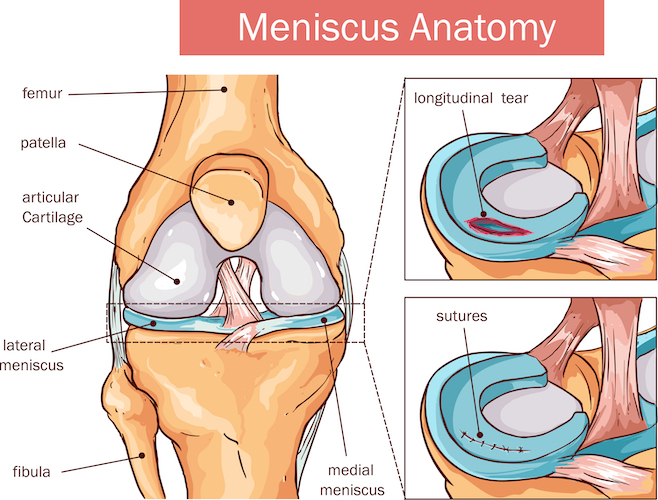If you recently suffered a meniscus tear, and are looking for knee treatment in Visalia, recent research shows we can help.
If you have a meniscus tear and have been told that surgery is the only answer, that’s not accurate. Surgery is not always necessary after a meniscus tear. In fact, specific types of tears, called non-obstructive tears, often don’t need any surgery at all.
Background Information About the Knee Menisci
The meniscus is a tough, rubbery, C-shaped piece of cartilage that rests between your shinbone (tibia) and thigh bone (femur) in the knee. Each knee has two menisci (plural of meniscus), with one on the inner and the other on the outer side of the knee. These menisci both serve the same purpose: to absorb shock and stabilize the knee.
Meniscus tears are among the most common knee injuries in sports. Athletes, especially those that play contact sports like football and soccer, have a higher risk of sustaining a tear to the meniscus, but the injury can occur in anyone at any age. In most cases, the meniscus tears as the result of twisting or turning quickly on a bent knee, often when the foot is planted on the ground. Older adults, on the other hand, are more likely to have degenerative meniscus tears after the cartilage weakens and wears thin over time.
Whatever the cause, the symptoms of a meniscus tear are usually quite similar. Some patients experience a “pop” or tearing sensation immediately after the tear, and there will usually be some sharp, intense pain either right away or soon after. This is typically accompanied by stiffness and swelling, an inability to move the knee normally and difficulty walking.
The Knife Is Not The Only Option
If a meniscus tear occurs, many people assume that surgery will be needed to repair it. Although this may be accurate for certain tears and for certain patients, it is not always the case. Treatment for these injuries depends on the size, type and severity of the tear, and in many cases, a patient can recover with conservative (non-surgical) treatment. A major component of conservative treatment for meniscus tears is physical therapy, which usually consists of the following:
- Ice and compression to control pain and swelling
- Laser therapy in increase blood flow and to facilitate healing
- Exercises to strengthen the quadriceps, hamstrings, calf and hip muscles, such as quad sets, heel raises, hamstring curls, knee bends and straight leg raises
- A home-exercise program consisting of a variety exercises and educational advice to avoid aggravating your knee
- An optional treatment called neuromuscular electrical stimulation, which applies an electrical stimulus to improve muscle strength of the quadriceps
- Instructions on how to maintain your fitness and activity levels, and guidance on when you can return to full activity
A recently published study shows how physical therapy compares to surgery and why it should be regarded as a strong alternative option when patients are making treatment decisions. The clinical scientists concluded in their research publication:
Among patients with nonobstructive meniscal tears, physical therapy was not inferior to surgery for improving patient-reported knee function over a 24-month follow-up period. Based on these results, physical therapy may be considered an alternative to surgery for patients with nonobstructive meniscal tears.
Meniscus tears are serious injuries, but as you can see, they do not always require surgery. If you have a meniscus tear and would like to know more about your treatment options, contact us here at Bacci & Glinn Physical Therapy and schedule an appointment. We are the conservative choice for meniscus tear treatment in Visalia.

